3.1.2: Venn Diagrams
- Page ID
- 74303
3.1.2 Learning Objectives
-
Use Venn diagrams to depict unions, intersections, and complements of sets
-
Create an expression to describe a section of a Venn diagram
To visualize the interaction of sets, John Venn in 1880 thought to use overlapping circles, building on a similar idea used by Leonhard Euler in the 18th century. These illustrations are now called Venn Diagrams.
Definition: Venn Diagram
A Venn diagram represents each set by a circle, usually drawn inside of a containing box representing the universal set. Overlapping areas indicate elements common to both sets.
Basic Venn diagrams can illustrate the interaction of two or three sets.
Example 1
Create Venn diagrams to illustrate \(A \cup B, A \cap B,\) and \(A^{c} \cap B\)
\(A \cap B\) contains all elements in both sets - elements in A and B.
\(A \cup B\) contains all elements in either set - elements in A or B (or both).
\(A^{c} \cap B\) contains elements outside of A and also in B.
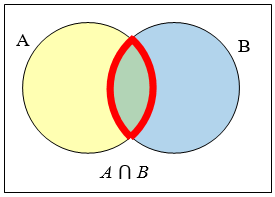 |
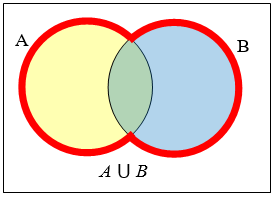 |
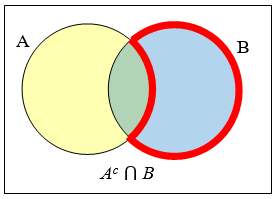 |
Example 2
Use a Venn diagram to illustrate \((H \cap F)^{c} \cap W\)
We'll start by identifying everything in the set \(\mathrm{H} \cap F\)
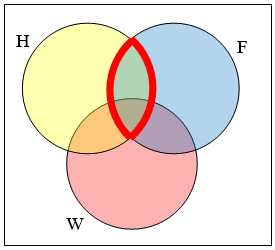
Now, \((H \cap F)^{c} \cap W\) will contain everything not in the set identified above that is also in set \(W\)
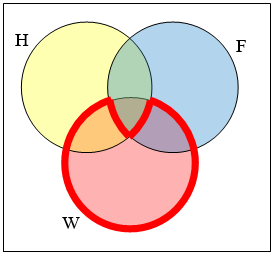
Example 3
Create an expression to represent the outlined part of the Venn diagram shown.
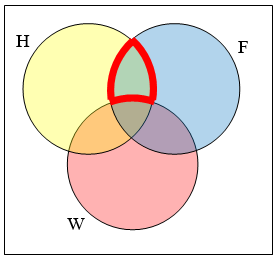
The elements in the outlined set are in sets \(\mathrm{H}\) and \(F\), but are not in set \(W\). So we could represent this set as \(H \cap F \cap W^{c}\)
Sometimes Venn diagrams include numbers to show the cardinality of each region in the diagram.
Example 4
Use the Venn Diagram representing the number of people who ordered the given ice cream flavors to answer the following questions.
- How many people ordered chocolate and strawberry?
- How many people ordered chocolate or strawberry?
- How many people ordered chocolate and strawberry but not vanilla?
- How many people ordered only vanilla?
- How many people ordered vanilla?
- How many people did not order chocolate, vanilla, or strawberry?
- How many people ordered all three flavors?
- How many total orders were there?
Solution
- Look at the intersection of chocolate and strawberry to see that 13 people ordered that combination.
- Look at the union of the chocolate circle with the strawberry circle to see that 79 people ordered chocolate or strawberry.
- Look at the intersection of chocolate and strawberry and exclude those who ordered vanilla.
- Look at the section of the vanilla circle that does not intersect with any other flavor to see that 6 people ordered only vanilla.
- Look at all of the regions inside the vanilla circle to see that 48 people ordered vanilla.
- Look outside the Venn diagram to see that 15 orders did not contain any of those flavors.
- Look in the center where all three circles overlap to see that 9 people ordered all three flavors.
- Add the numbers in each section of the Venn and the number outside the Venn to find that there were a total of 100 orders.
Try it Now 1
Create an expression to represent the outlined portion of the Venn diagram shown
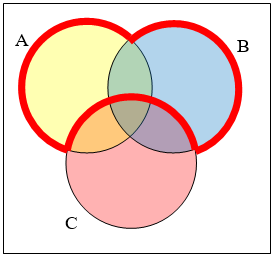
- Answer
-
\(A \cup B \cap C^{c}\)


